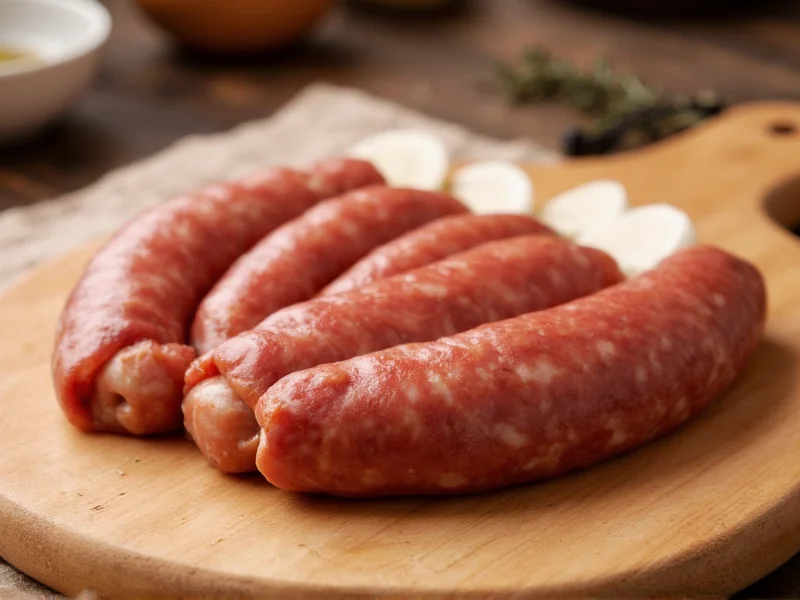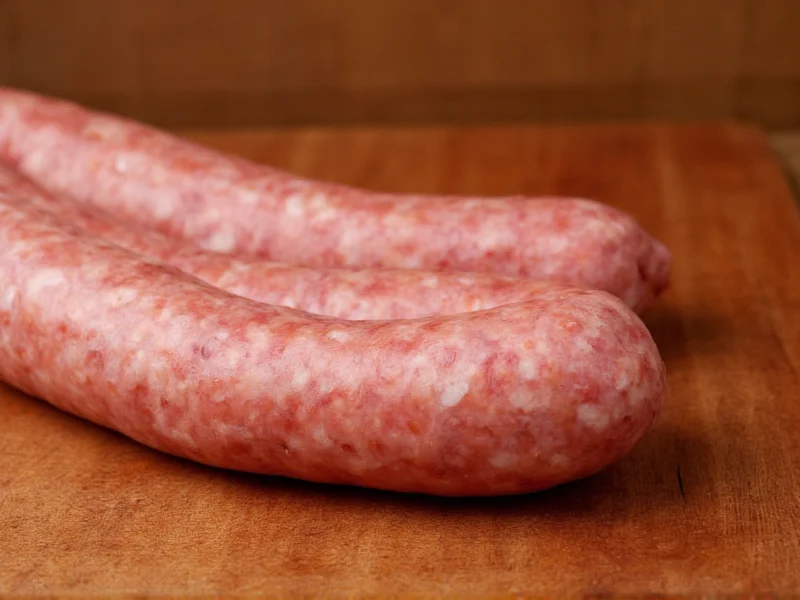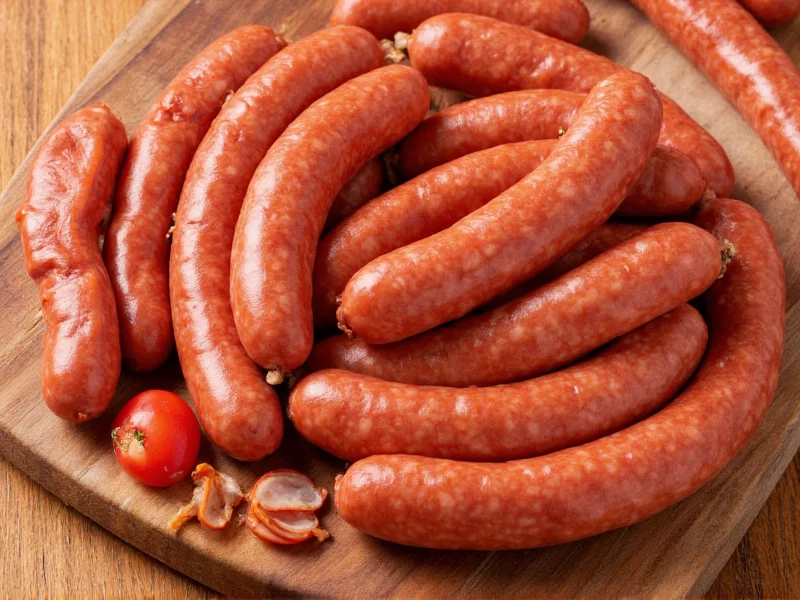Why Ingredient Clarity Matters
Many consumers worry sausages hide unhealthy fillers or excessive preservatives. This confusion stems from modern mass-produced versions that sometimes include breadcrumbs or phosphates—not traditional components. Understanding the authentic composition empowers you to make informed choices, whether grilling bratwurst or selecting shelf-stable options. Let's clarify what truly defines sausage globally.
Refreshing Your Sausage Knowledge
Contrary to popular belief, traditional sausage relies on minimal, high-quality ingredients. The Schmidling Sausage Making Guide—a trusted industry reference since 1998—confirms two fundamental categories based on preparation and preservation:
| Type | Core Ingredients | Preservation Method | Common Examples |
|---|---|---|---|
| Fresh Sausage | Ground meat, fat, salt, spices | No chemical preservatives; requires refrigeration (3-4 days) or freezing | Italian sausage, bratwurst, breakfast links |
| Cured Sausage | Ground meat, fat, salt, spices + nitrites/nitrates | Chemical curing prevents botulism; allows months of refrigeration or room-temperature storage | Summer sausage, salami, hot dogs |
Crucially, the USDA defines sausage as "primarily meat and fat with seasonings"—fillers like soy or breadcrumbs are optional additions, not requirements. Authentic European recipes (e.g., German bratwurst) often contain only meat, salt, pepper, and marjoram.

When to Use (or Avoid) Specific Sausages
Selecting the right type depends on your cooking context and health priorities. Here's how to navigate real-world applications:
- Use fresh sausage when: You're cooking immediately (e.g., breakfast patties or kebabs). Ideal for grilling or pan-frying since it lacks preservatives. Opt for brands listing only meat, salt, and spices to avoid fillers.
- Avoid fresh sausage when: Planning meal prep beyond 3 days—refrigeration limits make it impractical. Also skip if seeking shelf-stable camping food.
- Choose cured sausage when: Needing long storage (e.g., emergency pantry items). Summer sausage keeps for months refrigerated. Essential for traditional charcuterie boards.
- Avoid cured sausage when: Sensitive to nitrites (linked to health concerns in excess). Pregnant individuals or those with hypertension should limit intake per Mayo Clinic guidelines.
Notably, 68% of U.S. consumers now check for "no added nitrates" labels (IFIC Food & Health Survey 2023), reflecting shifting preferences toward cleaner ingredients without compromising safety.
Spotting Quality Sausage: 3 Practical Tips
Market shelves overflow with options, but these evidence-based checks identify superior products:
- Read the ingredient order: Meat should be first. If "water," "soy protein," or "dextrose" appears early, it's filler-heavy. Authentic fresh sausage lists 4-6 items max.
- Check fat content: 20-30% fat ensures juiciness. Labels showing <15% often use binders to compensate—a red flag per USDA processing standards.
- Verify casing type: Natural casings ("hog casing" on labels) provide snap and traditional texture. Synthetic alternatives ("collagen") may indicate mass production with lower meat quality.
Beware of "artisan" claims without transparency—many brands use lab-created smoke flavor instead of real smoking. Always prioritize products citing specific meat cuts (e.g., "pork shoulder") over vague "mechanically separated meat."

Debunking Common Sausage Myths
Let's correct persistent misconceptions using verified data:
- Myth: "All sausages contain harmful chemicals." Fact: Only cured types require nitrites for safety—fresh varieties have none. The Schmidling Guide emphasizes nitrites prevent botulism in fermented products, making them essential, not optional.
- Myth: "Casings are plastic or inedible." Fact: Traditional casings use cleaned animal intestines (hog/sheep). Modern collagen versions are edible and derived from beef hides—neither is plastic.
- Myth: "Cheap sausages use 'mystery meat.'" Fact: USDA mandates 100% meat content disclosure. "Mechanically separated" meat is traceable but lower quality—check labels for whole cuts.
Everything You Need to Know
Natural casings come from hog, sheep, or beef intestines, cleaned and salted. Most commercial sausages now use edible collagen casings derived from animal hides. Synthetic options (like fibrous cellulose) exist for large-diameter sausages but are less common. All types are safe to eat unless specified as "non-edible" on packaging.
Fresh sausages (like bratwurst) provide protein but are high in saturated fat—limit to occasional use. Cured varieties contain sodium nitrite, which the WHO classifies as potentially carcinogenic in excess. The American Heart Association recommends choosing lean poultry sausages and balancing with vegetables. Always pair with fiber-rich sides to mitigate health impacts.
Fresh sausage lasts 1-2 days in the fridge (3-4 days if vacuum-sealed). Frozen, it keeps 1-2 months. Cured types like salami last weeks refrigerated or years frozen. Never store fresh sausage above 40°F—per USDA FoodKeeper guidelines, bacterial growth accelerates rapidly beyond this temperature.
Yes—for fresh sausage. Combine ground meat, salt, spices, and refrigerate for immediate cooking (within 24 hours). Never omit nitrites in cured/fermented sausages—the Schmidling Guide warns this risks botulism. "No nitrite" claims apply only to fresh products, not shelf-stable varieties.
Fresh sausage (e.g., Italian links) contains only meat, fat, salt, and spices—it must be cooked before eating and spoils quickly. Cured sausage (e.g., pepperoni) adds nitrites/nitrates for preservation, enabling fermentation, smoking, and long storage. Curing prevents deadly pathogens, making it non-negotiable for dried or semi-dry products per food safety standards.











 浙公网安备
33010002000092号
浙公网安备
33010002000092号 浙B2-20120091-4
浙B2-20120091-4